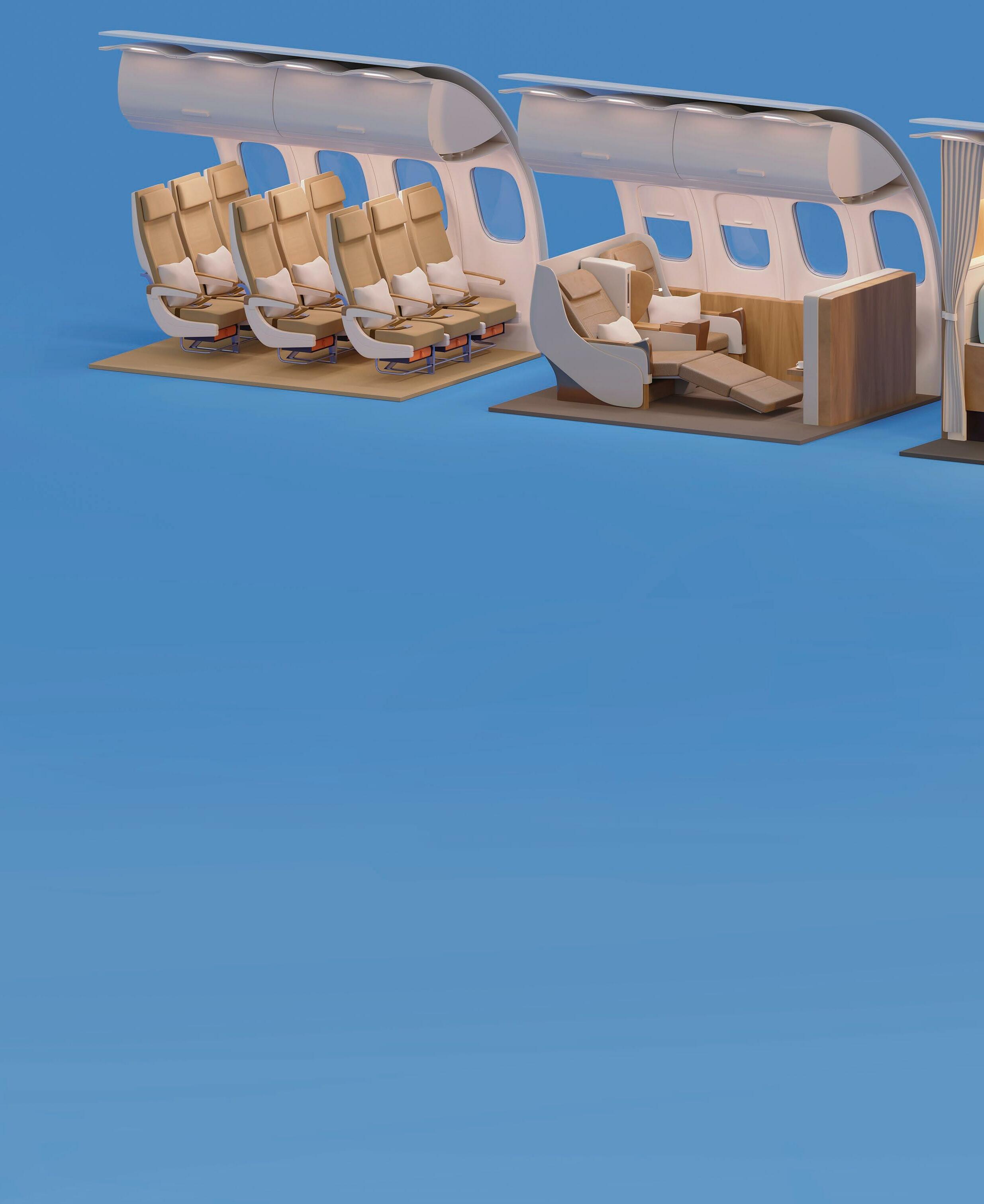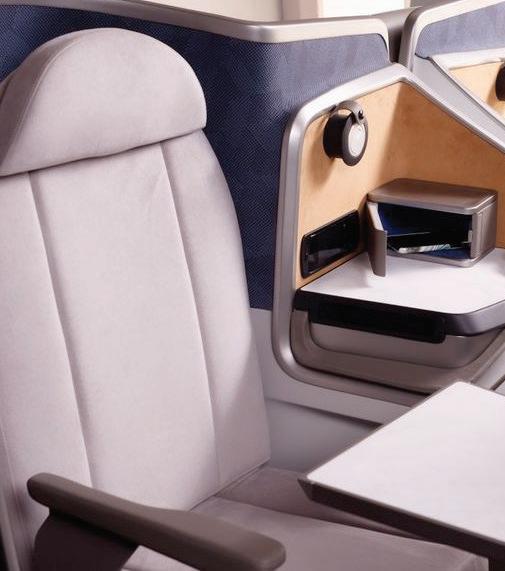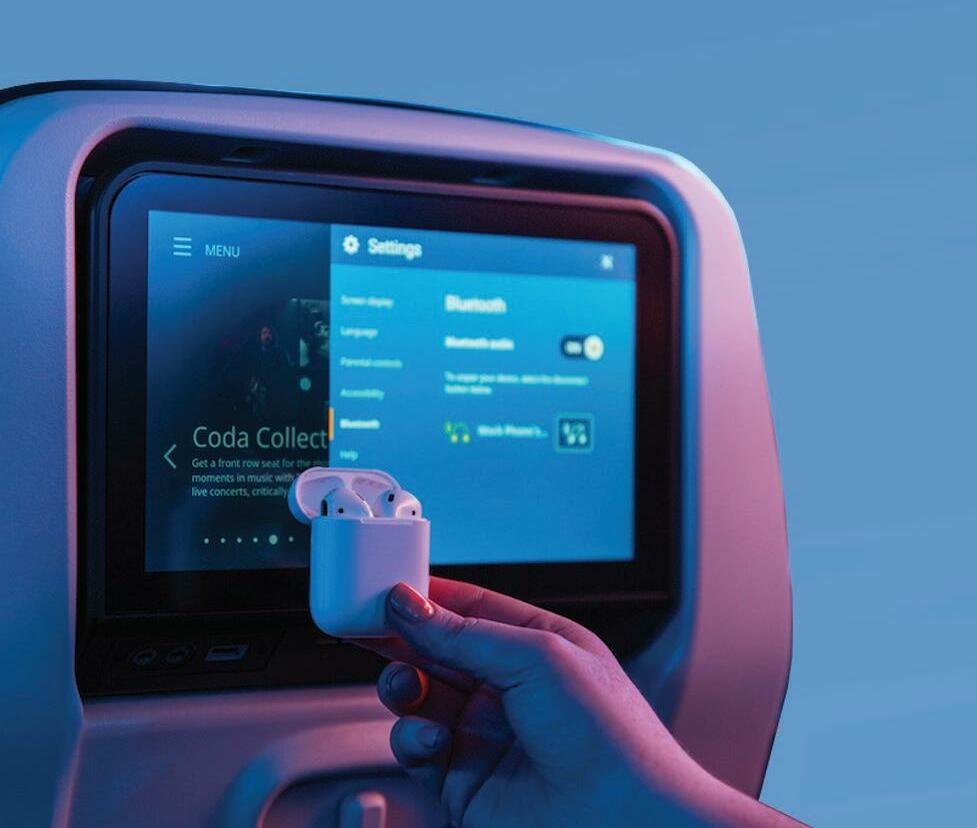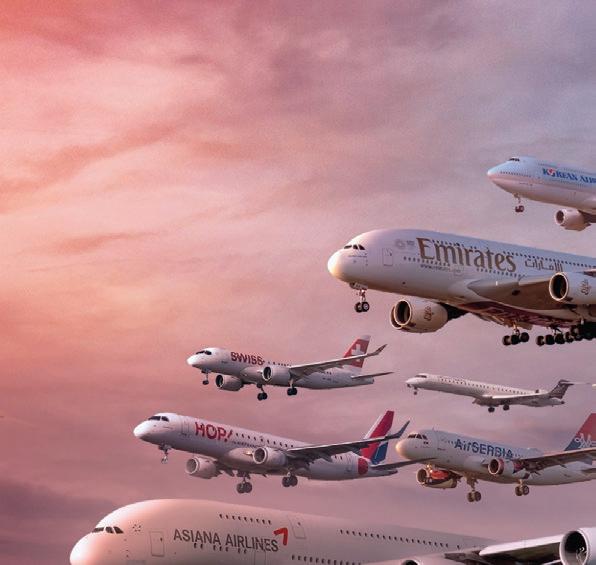
13 minute read
OPINION: David Whelan, Valour Consulting / 14 DEVICES IN FOCUS: Getting Personal / 16 INTERIORS UPDATE: Sitting Pretty / 19 HOW TO.. Sell well digitally /
OPINION / 13
The digital cabin apps in action
David Whelan, senior analyst at Valour Consultancy, shares his thoughts on the rise of digital cabin applications
As the aviation industry emerges from the COVID downturn and global air passenger numbers begin to recover, many airlines are looking to digital cabin applications to improve operational efficiency and increase passenger satisfaction.
Many airlines have sought to reduce touchpoints in the cabin and minimise unnecessary interaction between crew and passengers. Crew-facing tools such as cabin management applications are optimising operations onboard by reducing the amount of time that the crew has to spend performing repetitive tasks, and freeing up time to focus on passenger needs.
Leading solutions help the crew perform pre-, in, and post-flight tasks all in one easy- to-use platform. As well as filling in and submitting reports, applications can also help the crew keep track of passenger specific information such as dietary requirements or pre-flight requests. Key to this are passenger seat maps, which enable the crew to keep track of the whole cabin as well as focussing in on individual passenger requirements at the touch of a button.
Low-cost appeal
Cabin management apps, as well as wireless IFE platforms, are proving particularly popular among LCCs that are keen to maximise operational efficiency and enhance ancillary revenue generation. The number of LCC aircraft equipped with a cabin management application is set to grow from around 1,800 today to more than 5,000 by the end of the decade.
Essential tools
In addition to cabin management tools, app-based POS platforms such as those from AirFi, Retail inMotion and Gategroup are enabling airlines to revolutionise onboard sales and ancillary revenue generation. As well as payment processing, these solutions can also perform assist with inventory management, load passenger pre-order information, keep track of passenger loyalty points, and offer upselling opportunities.
There are a myriad of benefits to digitalising the cabin and an increasing number of airlines are now looking to holistic cabin management applications as a necessity, rather than a “nice to have.” •
Holistic cabin management apps are increasingly seen as a necessity, rather than a 'nice to have'
14 / personAl electronic devices
Getting personal
Passenger familiarity with their own electronic devices has grown exponentially in recent years but what are the pros and cons of this trend for airlines? Julie Baxter learns more
As travellers return to the sky, it is critical to understand their motivations and mitigate bad experiences before they happen. Tech is key. Travellers are increasingly ‘always on’ and opportunities abound to add personalised and frictionless experiences across the entire journey. Providing familiar experiences that mirror those on the ground - where passengers are most comfortable – is the priority, and this has turned the spotlight onto personal electronic devices (PEDs) – now at the heart of the experience. With passengers always connected, surprising and memorable experiences in retail, F&B and entertainment can be designed with insights from analytic data observation and AI.
In flight, PEDs can also be used to communicate with onboard tech. They can be paired to the seatback set ups if installed, or used to deliver exclusive streamed content. Passengers can even download content to take off the aircraft, and are enabled to use their flying time more productively.
While some airlines are committed to seatback displays, the growing reliance on PEDs on the ground is making others question the expense of installation, maintainence, weight and updates.
Mirroring trends
Juraj Siska, from IdeaNova, says: “The growing popularity of on-demand streaming media through subscription platforms such as Netflix, Amazon Prime and Peacock has brought tremendous change. Technology has stayed in lock step with this trend allowing the delivery of content directly to the browers of any passenger’s device, eliminating the need for native applications, and offering the ability to deliver more content on a similar bandwidth through modern video coding standards such as HEVC, AV1, VP9.”
He fears airlines risk falling behind the streaming trend if they lock into seat back displays and adds: “More content and higher quality of content (e.g. 4K, HDR) will require more bandwidth and better decoders. The streaming industry is likely to experience more changes as a result of new video coding standards (e.g. VVC), and the adaption of big technology vendors to new standards and trends. These changes occur rapidly and are quickly reflected in PEDs. Custom displays in aircraft become static and quickly obsolete unless airlines can seamlessly mirror the trends. Seat back displays are typically monolithic, stationary systems less able to change fast.”
personAl electronic devices / 15
He envisages new features coming that will enable customers to rate content; view personalised content and socialise with other passengers while watching movies and TV shows.
He adds: “Onboarding new features via PEDs is simple, whether browser based or through an airline’s native application. In browser content, delivery has been dominating the internet for the last 15 years and with the advent of rich application technologies, such as ReactJS, it is likely here to stay. But even native applications facilitate deployment of new features more rapidly than built-in displays.”
Battery anxiety
Critical to these digital experiences is, of course, the ability for passengers to charge and power their devices in the cabin. Without power, the experience diminishes, so in-seat power is essential, says David Pook, vp marketing & sales support, at Burrana. He says: “To maximise the value of these investments, 'battery anxiety' must be addressed, enabling the experience to last the duration of the flight, and long after arrival.”
Solutions, such as RISE Power, address this with affordable, compact, and easy-to-install solutions. Burrana has a 48VDC common power backbone which allows airlines to mix and match 15W, 60W and 110V power across seat zones/ classes. With full 15W charging (3 amps) via USB-A ports, passengers can charge their devices 50% faster. As demand grows for 60W USB-C charging, airlines can swap out the jacks. Pook believes airlines can even earn revenue from this with 'payto-charge' options, as well as capturing usage data for insights into passenger behaviour. Anxieties around IFE hygiene have added another reason to favour PEDs, paired with their own headsets.
While a total switch to PED models is unlikely, a hybrid model, offering that options, will only improve passenger loyalty and satisfaction, and build added flexibility and IFE choice. •
#SmileWithOBH
16 / SEATING INNOVATIONS
Sitting pretty

As the doors open on the Aircraft Interiors Expo post-covid challenges and new trends are driving new seating designs and tech choices, says Angela Youngman

The airline industry is emerging from two years of Covid. It faces increasing fuel costs, sustainability issues and changing passenger expectations. All are impacting cabin design and choices.
Seating styles, materials used and the technology enabled are all key, and options around improved in-seat connectivity are particularly gaining ground.
Ben McGuire, CEO of Mirus Aircraft Seating, explains: “The priority is to bring the technologies of home into aircraft interiors to provide a seamless journey from home to destination. Airlines are looking for space-saving, decluttering technology integrated into the cabin, such as USB power, hands-free options, wireless charging and personal electronic device (PED) streaming.”

Smart compromises
His company’s solution is the latest Mirus Hawk Seat, with options for USB charging points and a built-in PED holder. Designed particularly with Boeing 737 and A320 aircraft in mind, the seat is ergonomically sculptured to offer maximum legroom and mechanical recline system.
Similarly the newest seat from Haeco Cabin Solutions has been designed as a smart compromise between weight, comfort and durability. It is an 8kg slimline seat for narrow-body jets which achieves a 29-inch pitch and includes a drop down table and full bottom cushion, as used on long-haul flights.
Eurowings is to retrofit with the Essenza seat from Geven. Ergonomically crafted for maximum comfort at the utmost cost efficiency, the seat features in-arm and rear meal tables with a dedicated PED holder, coat hook, literature and amenity pockets, plus super-comfort cushions.
David Whelan, of Valour Consultancy, notes a post-pandemic trend that reflects the down turn in business travel: "It may be that we see cabins being reconfigured with a scaled-down or smaller business class, and then see bigger premium economy cabins to meet that premium leisure demand. We also continue to see long range narrow-bodies adopt wide-body-esque amenities such as lie-flat seating and privacy doors. Given this market is going from strength to strength at the moment, it’s worth keeping an eye on.”
market is going from strength to strength at the moment, it’s worth keeping an eye on.”

Above right: Eurowings prepares to retrofit with Geven's Essenza Right from top: Stelia's Opal seat; Thompson's VantageSolo; and Panasonic Avionics focuses on Avionics focuses on Bluetooth options Bluetooth options






ISTOCKPHOTO.COM/ TARRAS79
SEATING INNOVATIONS / 17

Order book indications
Aircraft order books point up this change too with strong demand for narrow body aircraft that perform strongly in terms of costs per passenger per mile such as the A321. If these single aisle aircraft are to appeal to the business market however, they need a seat that competes with those familiar on wide body jets so designers are innovating to suit. Thompson has the VantageSolo seat, already adopted by JetBlue and Stelia will showcase its Opal Seat to meet this trend. New player Unum, led by former Acro chief Chris Brady, will reveal its new concept in this space at AIX. Recaro too will be unveiling new concepts to 'drive comfort in the cabin', and many are watching to see how the pared back Finnair seat – designed for lie flat without complex mechanisms – will pan out. Design teams continue to look for new seat layouts, streamlining interiors to be more ergonomic and using new durable textiles. TU Delft and Zephyr Aerospace have worked on innovative double decker concepts for use in economy, while at LSEAT, attention has been focused on premium economy seating for long haul flights. Yves Hendricks, CEO, explains: “Flights are getting longer – up to 15 or 17 hours – and we believe the best passenger experience improvement is better sleep inflight, and we believe this is even more important than IFE.” LSEAT’s solution, already on two airlines, quickly converts from seat
to sleep mode, while maintaining the row pitch and cabin passenger density. Passengers extend their legs under the seat in front and their own weight operates the change. New designs are also bringing seat weights down as airlines commit to sustainability targets and hence reducing the overall weight of the aircraft becomes a growing priority to make every journey more fuel efficient.
Fabrics and finishes
Fabrics and finishes are under the spotlight too. Wood effect finishes on bulk heads and through cabins are adding a softer, eco mood, while synthetic leathers for seat covers are ever improving and carry a sustainability bonus too. The weight of synthetic leather is up to 65% lighter than traditional hide, durable and stain resistant. Seats with power and device holders are becoming the new must-have as passengers increasingly demand the familiarity of their own devices and technology for inflight entertainment. The role of Bluetooth capability is gaining ground on innovative double decker concepts for use too. Panasonic Avionics’ Bluetooth Audio solution in economy, while at LSEAT, attention has for example is activated via the IFE screen and been focused on premium economy enables passengers to use their own Bluetooth seating for long haul flights. Yves headphones with the airline's IFE system. United Hendricks, CEO, explains: “Flights Airlines already rolled these out on its Boeing 737 are getting longer – up to 15 or MAX8s, and this fleet has the highest NPS (net 17 hours – and we believe the promoter scores) of all of its aircraft. best passenger experience Burrana has looked to address the power anxiety improvement is better sleep issue of PEDs with its RISE Power innovation, a inflight, and we believe this small, light-weight kit offering the fastest charging is even more important yet (see page 14), and Collins Aerospace is among than IFE.” LSEAT’s solution, those focusing on enhancing the passenger already on two airlines, IFE whilst also improving crew options via its quickly converts from seat Connected Cabin solutions. •
Collins Aerospace is among those focusing on enhancing the passenger IFE whilst also improving crew options via its













HOW TO... / 19
How to... ...sell digitally
Promoting food and beverage products digitally brings new challenges and opportunities. Food photographer Miguel Mas Martinez turns his lens on the digital retail trend
EmbracE THE TrEnd
A digital menu has some very positive advantages. There are no space limitations, as with printed menus; images look much sharper and brighter; and the retailer can communicate with the passenger in a language they are very used to already: through social networks viewed on their own devices.
adapT yOur fOrmaTs
Photographs for a digital menu must be adapted for the screens of all sizes but we can use clean, uncluttered images and put text elsewhere as space is more flexible. This helps improve product visibility.
rEcOgnisE OppOrTuniTy
Digital menus give huge flexibility. Products can be changed or details updated quickly, corrections or modifications require no reprints and, in these eco-friendly times, they also cut the need for paper use and add to a programme's sustainability.
ExpErimEnT
Digital menus allow passengers to access an index they can search and browse. They can click on an object to see its price but also work to attract passenger attention with engaging videos, gifs, animations and the like.
crEaTE as a TEam
The creative process for a digital menu is best when it involves all parties: photo studio, advertising agency, retailer and airline company. They work to agree a colour palette, types of backgrounds, style of crockery or decoration (the props), the type of shadows (hard, soft) and the warmer or colder environment. The aim is to create a mood, a tone that corresponds with the airline brand and the season, and which compliments the range on offer.
pHOTOs arE a salEs TOOl
Images once created can be digitally retouched to correct imperfections and to suit the layouts. Digital menus, where good internet is available, are key tools for boosting sales and have to be an integral part of the operator's brand image. It is important that the passenger feels that the whole inflight experience revolves around common aesthetic elements. Putting effort into the detail is the way to make sure the final result and sales are optimised.•





